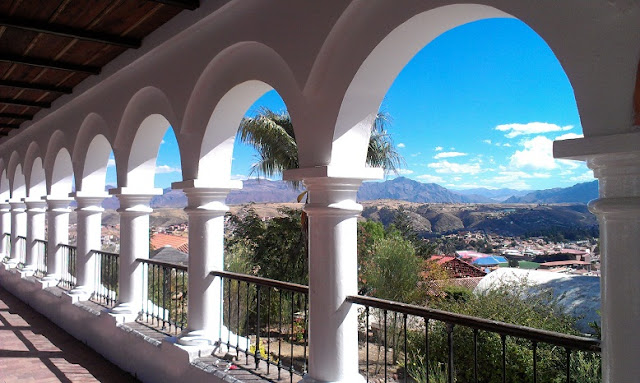Sucre was down in the lowlands at just 2800m, and we were happy as it was a bit warmer. We walked along the cobble streets, taking in the lovely squares and visited Parque Bolivar where there was a 'replica' of the Eiffel Tower (it was a bit wobbly).
We went to the cinema and despite most of Bolivia living without hot water (or windows!), the 3D glasses and cinema screen were second to none as we watched The Great Gatsby. Sucre was quite busy and full of students, and due to the younger population, most people were dressed as they do in Europe, except for around the market where the Cholitas (traditionally dressed Aymara ladies) were everpresent, selling all combinations of salsa, guacamole, chilli and mayonnaise which people were snapping up in plastic bags.
We chilled a bit after all the travelling and spent an afternoon playing chess in the sunshine at a cafe on top of a hill overlooking the city. We also visited an impressive cemetery with lots of big tombs on one side and lots of shelves of graves (all stacked on top of each other) on the opposite side.
Thoroughly relaxed, it was time for a nightmare bus journey. Everybody we'd met had said Bolivian buses were terrible, but so far we had found them okay (despite having no toilets and only stopping once every 3 or 4 hours). Our luck was about to change.
We booked onto a 'Cama' bus to La Paz. This was a luxury bus with toilet, a seat that reclined to flat and heating on board for just 130 Bolivianos. The toilet was out of order, but we could live with that, so long as we stopped now and again along the way. The journey was supposed to take 12 hours and we set off at 7.30pm. After snoozing a bit, we woke up at 1am to find the bus had stopped and the engine was off. We had no idea why, but the bus remained here in the middle of nowhere, 4,000m above sea level until 7am. With the heating off it was impossible to sleep, and we spent the night shivering with the condensation on the window turning to ice in the freezing temperature.
Once the sun was up, it began to warm up and we were thankful to rest a bit now that it was warmer. Soon it was too hot and stuffy with the midday sun shining directly onto us through the front window. We played Cambio (a card game we had learnt in Brazil) to pass the time and eventually we arrived in La Paz in the late afternoon.







No comments:
Post a Comment